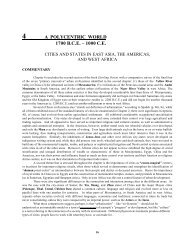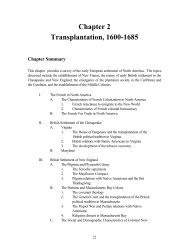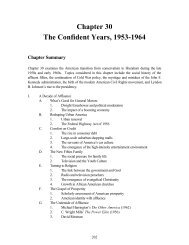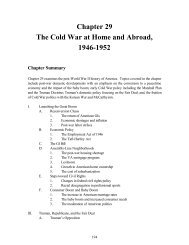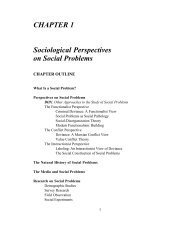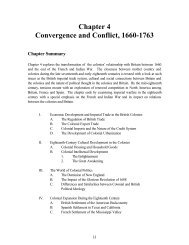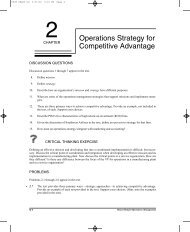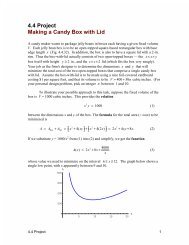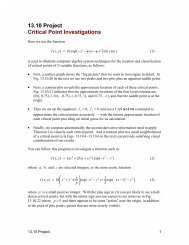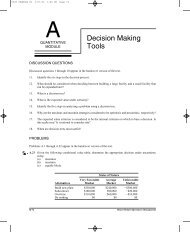Merchandising Operations and the Accounting Cycle - Pearson
Merchandising Operations and the Accounting Cycle - Pearson
Merchandising Operations and the Accounting Cycle - Pearson
Create successful ePaper yourself
Turn your PDF publications into a flip-book with our unique Google optimized e-Paper software.
Austin paid within <strong>the</strong> discount period so its cash payment entry is<br />
June 10 Accounts Payable ....................................................... 707.00<br />
Cash ........................................................................ 685.79<br />
Inventory................................................................ 21.21<br />
Paid on account within discount period.<br />
The discount is $21.21 [707.00 0.03]<br />
After paying <strong>the</strong> account, Austin Sound’s assets <strong>and</strong> liabilities both decrease, as<br />
follows:<br />
ASSETS = LIABILITIES + SHAREHOLDERS’ EQUITY<br />
Cash + Inventory = Accounts Payable<br />
–$685.29 -$21.21 = –$707 + 0<br />
–$707<br />
Note <strong>the</strong> credit to Inventory. After Austin Sound has taken its discount, Austin<br />
Sound must adjust <strong>the</strong> Inventory account to reflect its true cost of <strong>the</strong> goods. In<br />
effect, this inventory cost Austin Sound $685.79 ($707.00 minus <strong>the</strong> purchase discount<br />
of $21.21 [3% of $707.00]), as shown in <strong>the</strong> following Inventory account:<br />
Inventory<br />
May 27 707.00 June 10 21.21<br />
Bal. 685.79<br />
However, if Austin Sound pays this invoice after <strong>the</strong> discount period, it must<br />
pay <strong>the</strong> full invoice amount. In this case, <strong>the</strong> payment entry is<br />
June 29 Accounts Payable ....................................................... 707.00<br />
Cash ........................................................................ 707.00<br />
Paid on account after discount period.<br />
Without <strong>the</strong> discount, Austin Sound’s cost of <strong>the</strong> inventory is <strong>the</strong> full amount of<br />
$707, as shown in <strong>the</strong> following T-account:<br />
May 27 707.00<br />
Inventory<br />
Purchase Returns <strong>and</strong> Allowances<br />
Most businesses allow <strong>the</strong>ir customers to return merch<strong>and</strong>ise that is defective, damaged<br />
in shipment, or o<strong>the</strong>rwise unsuitable. Or if <strong>the</strong> buyer chooses to keep damaged<br />
goods, <strong>the</strong> seller may deduct an allowance from <strong>the</strong> amount <strong>the</strong> buyer owes. Both purchase<br />
returns <strong>and</strong> purchase allowances decrease <strong>the</strong> amount that <strong>the</strong> buyer must pay<br />
<strong>the</strong> seller.<br />
Suppose <strong>the</strong> $70 CD player (model LA100) purchased by Austin Sound Centre Inc.<br />
(in Exhibit 5-3) was not <strong>the</strong> CD player ordered. Austin Sound returns <strong>the</strong> merch<strong>and</strong>ise<br />
to <strong>the</strong> seller <strong>and</strong> records <strong>the</strong> purchase return as follows:<br />
June 3 Accounts Payable ....................................................... 70.00<br />
Inventory................................................................ 70.00<br />
Returned inventory to seller.<br />
Now assume that one of <strong>the</strong> JVC CD players was damaged in shipment to Austin<br />
Sound Centre Inc. The damage is minor, <strong>and</strong> Austin decides to keep <strong>the</strong> CD player<br />
in exchange for a $10 allowance from JVC. To record this purchase allowance, Austin<br />
Sound Centre Inc. makes this entry:<br />
June 4 Accounts Payable ....................................................... 10.00<br />
Inventory................................................................ 10.00<br />
Received a purchase allowance.<br />
Chapter Five <strong>Merch<strong>and</strong>ising</strong> <strong>Operations</strong> <strong>and</strong> <strong>the</strong> <strong>Accounting</strong> <strong>Cycle</strong> 229



